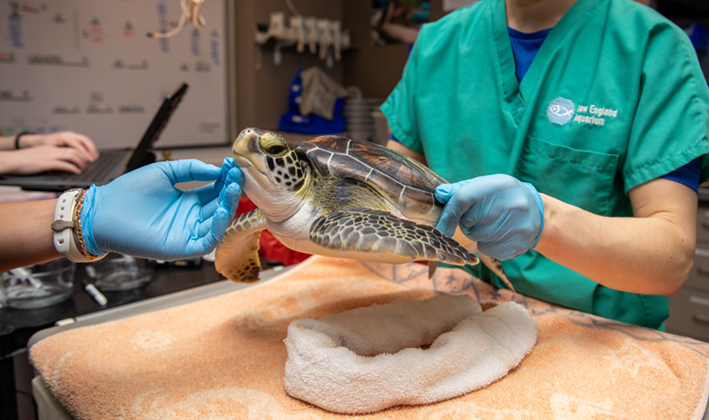
BOSTON, MASS. (Oct. 14, 2025) – The New England Aquarium is celebrating the improved status of green sea turtles from Endangered to Least Concern, following decades of conservation action.
The International Union for Conservation of Nature (IUCN) made the announcement at the IUCN World Conservation Congress being held in Abu Dhabi. Green sea turtles are a keystone species found in tropical and subtropical marine ecosystems around the world, including New England waters. Since the 1970s, the global population of green sea turtles has increased about 28 percent, leading to the change in conservation status despite ongoing threats to some subpopulations, IUCN said.
“This is a major win for sea turtles that illustrates the power that global conservation efforts can have over time,” said Dr. Letise LaFeir, Chief of Conservation and Stewardship at the New England Aquarium. Dr. LaFeir is leading a delegation of experts and scientists from the Aquarium currently in Abu Dhabi for the IUCN World Conservation Congress and Members’ Assembly, where IUCN is setting its conservation priorities for the next four years. The Aquarium became an IUCN member earlier this year and was recognized due to its commitment to conservation and the IUCN mission, demonstrated through extensive animal care, innovative scientific research, and marine conservation and education work.
For decades, the New England Aquarium has rescued, rehabilitated, and studied green sea turtles. The Aquarium’s Rescue and Rehabilitation team spends months each year caring for sick and injured green sea turtles at its Sea Turtle Hospital in Quincy, Mass. Scientists study the health of sea turtles in the hospital and after they’ve been released to improve survival of stranded turtles and to better understand wild populations. Researchers in the Aquarium’s Anderson Cabot Center for Ocean Life also use innovative methods to study sea turtle survival, movement, and behavior using satellite and acoustic tags, supporting recovery and conservation of the species.
“The best way to safeguard green sea turtles for future generations is through collaborative research and science-based protections. We hope the work we’re doing will help keep the species moving in a positive direction,” said Dr. Kara Dodge, research scientist in the Aquarium’s Anderson Cabot Center.
In addition to the Aquarium’s active conservation work, the most well-known animal at its home on Boston’s Central Wharf is a green sea turtle. Myrtle, who is estimated to be between 75 and 95 years old, has been an ambassador for her species at the Aquarium since 1970. She serves as a symbol of marine animal conservation and has inspired many Aquarium visitors to become ocean advocates.
MEDIA CONTACT: Pam Bechtold Snyder—617-686-5068; psnyder@neaq.org
